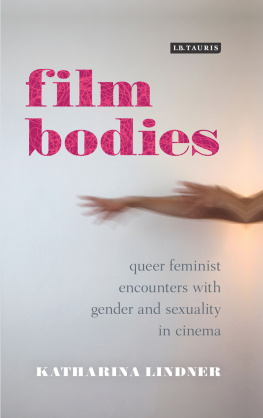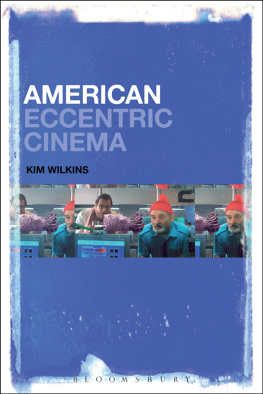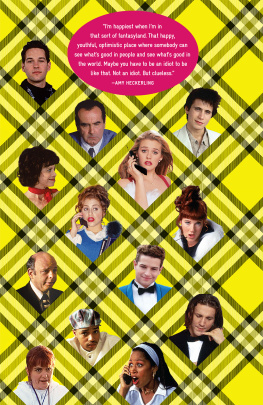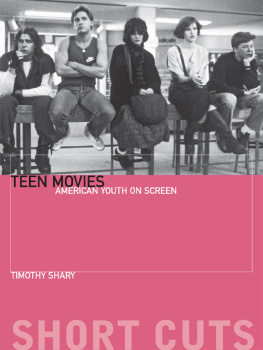
Clueless
Clueless: American Youth in the 1990s is a timely contribution to the increasingly prominent academic field of youth film studies. The book draws on the social context of the films release, a range of film industry perspectives including marketing, audience reception and franchising, as well as postmodern theory and feminist film theory to assert the cultural and historical significance of Amy Heckerlings film and reaffirm its reputation as one of the defining teen films of the 1990s.
Lesley Speed examines how the film channels aspects of Anita Loos 1925 novel Gentlemen Prefer Blondes, the 1960s television series Gidget and Jane Austens Emma to present a heightened, optimistic view of contemporary American teenage life. Although the film is seemingly apolitical, the book makes the case for Clueless as a feminist exploration of relationships between gender, comedy and consumer culture, centring on a contemporary version of the dumb blonde type. The film is also shown to embrace diversity in its depiction of African American characters and by contributing to an increase in gay teenagers on screen. Lesley Speed concludes her analysis by tracking the rise of the Clueless franchise and cult following. Both helped to cement the film in popular consciousness, inviting fans to inhabit its fantasy world through spinoff narratives on television and in print, public viewing rituals, revivalism and vintage fashion.
Lesley Speed is a lecturer in Media and Screen Studies at Federation University Australia. Her research focuses on youth film, screen comedy, discourses of generation and cultural value. Her previous book is Australian Comedy Films of the 1930s: Modernity, the Urban and the International.
Cinema and Youth Cultures
Series editors: Sin Lincoln and Yannis Tzioumakis
Cinema and Youth Cultures engages with well-known youth films from American cinema as well as the cinemas of other countries. Using a variety of methodological and critical approaches the series volumes provide informed accounts of how young people have been represented in film, while also exploring the ways in which young people engage with films made for and about them. In doing this, the Cinema and Youth Cultures series contributes to important and longstanding debates about youth cultures, how these are mobilized and articulated in influential film texts and the impact that these texts have had on popular culture at large.
Clueless
By Lesley Speed
Clueless
American Youth in the 1990s
Lesley Speed
First published 2018
by Routledge
2 Park Square, Milton Park, Abingdon, Oxon OX14 4RN
and by Routledge
711 Third Avenue, New York, NY 10017
Routledge is an imprint of the Taylor & Francis Group, an informa business
2018 Lesley Speed
The right of Lesley Speed to be identified as author of this work has been asserted by her in accordance with sections 77 and 78 of the Copyright, Designs and Patents Act 1988.
All rights reserved. No part of this book may be reprinted or reproduced or utilised in any form or by any electronic, mechanical, or other means, now known or hereafter invented, including photocopying and recording, or in any information storage or retrieval system, without permission in writing from the publishers.
Trademark notice: Product or corporate names may be trademarks or registered trademarks, and are used only for identification and explanation without intent to infringe.
British Library Cataloguing-in-Publication Data
A catalogue record for this book is available from the British Library
Library of Congress Cataloging-in-Publication Data
A catalog record for this book has been requested
ISBN: 978-1-138-68121-7 (hbk)
ISBN: 978-1-315-56435-7 (ebk)
Typeset in Times New Roman
by Apex CoVantage, LLC
Despite the high visibility of youth films in the global media marketplace, especially since the 1980s when Conglomerate Hollywood realized that such films were not only strong box office performers but also the starting point for ancillary sales in other media markets as well as for franchise building, academic studies that focused specifically on such films were slow to materialize. Arguably the most important factor behind academias reluctance to engage with youth films was a (then) widespread perception within the Film and Media Studies communities that such films held little cultural value and significance, and therefore were not worthy of serious scholarly research and examination. Just like the young subjects they represented, whose interests and cultural practices have been routinely deemed transitional and transitory, so were the films that represented them perceived as fleeting and easily digestible, destined to be forgotten quickly, as soon as the next youth film arrived on cinema screens a week later.
Under these circumstances, and despite a small number of pioneering studies in the 1980s and early 1990s, the field of youth film studies did not really start blossoming and attracting significant scholarly attention until the 2000s and in combination with similar developments in cognate areas such as girl studies. However, because of the paucity of material in the previous decades, the majority of these new studies in the 2000s focused primarily on charting the field and therefore steered clear of long, in-depth examinations of youth films or was exemplified by edited collections that chose particular films to highlight certain issues to the detriment of others. In other words, despite providing often wonderfully rich accounts of youth cultures as these have been captured by key films, these studies could not have possibly dedicated sufficient space to engage with more than just a few key aspects of youth films.
In more recent (post-2010) years a number of academic studies started delimiting their focus and therefore providing more space for in-depth examinations of key types of youth films, such as slasher films and biker films, or examining youth films in particular historical periods. From that point on, it was only a matter of time before the first publications that focused exclusively on key youth films from a number of perspectives to appear (Mamma Mia! The Movie, Twilight and Dirty Dancing are among the first films to receive this treatment). Conceived primarily as edited collections, these studies provided a multifaceted analysis of these films, focusing on such issues as the politics of representing youth, the stylistic and narrative choices that characterize these films and the extent to which they are representative of a youth cinema, the ways these films address their audiences, the ways youth audiences engage with these films, the films industrial location and other relevant issues.
It is within this increasingly maturing and expanding academic environment that the Cinema and Youth Cultures volumes arrive, aiming to consolidate existing knowledge, provide new perspectives, apply innovative methodological approaches, offer sustained and in-depth analyses of key films and therefore become the go to resource for students and scholars interested in theoretically informed, authoritative accounts of youth cultures in film. As editors, we have tried to be as inclusive as possible in our selection of key examples of youth films by commissioning volumes on films that span the history of cinema, including the silent film era; that portray contemporary youth cultures as well as ones associated with particular historical periods; that represent examples of mainstream and independent cinema; that originate in American cinema and the cinemas of other nations; that attracted significant critical attention and commercial success during their initial release; and that were rediscovered after an unpromising initial critical reception. Together these volumes are going to advance youth film studies while also being able to offer extremely detailed examinations of films that are now considered significant contributions to cinema and our cultural life more broadly.








